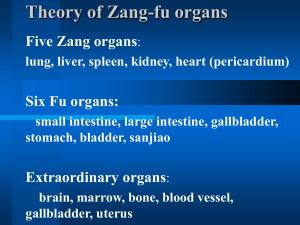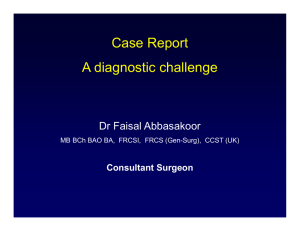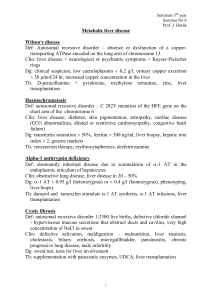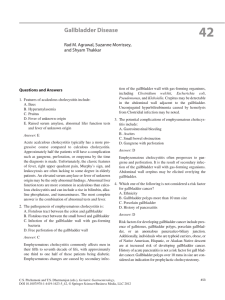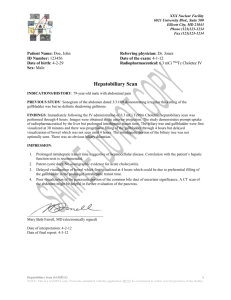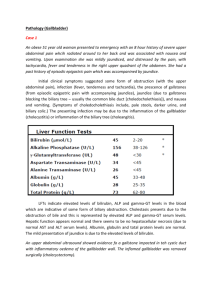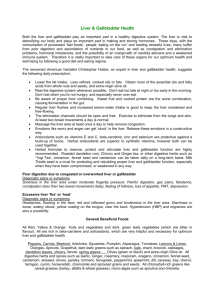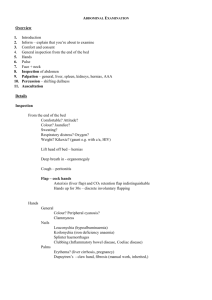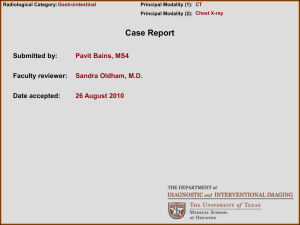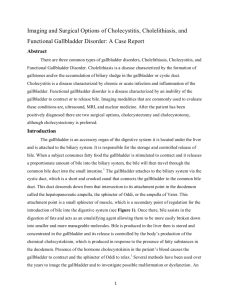Palpable mass in the abdomen
advertisement
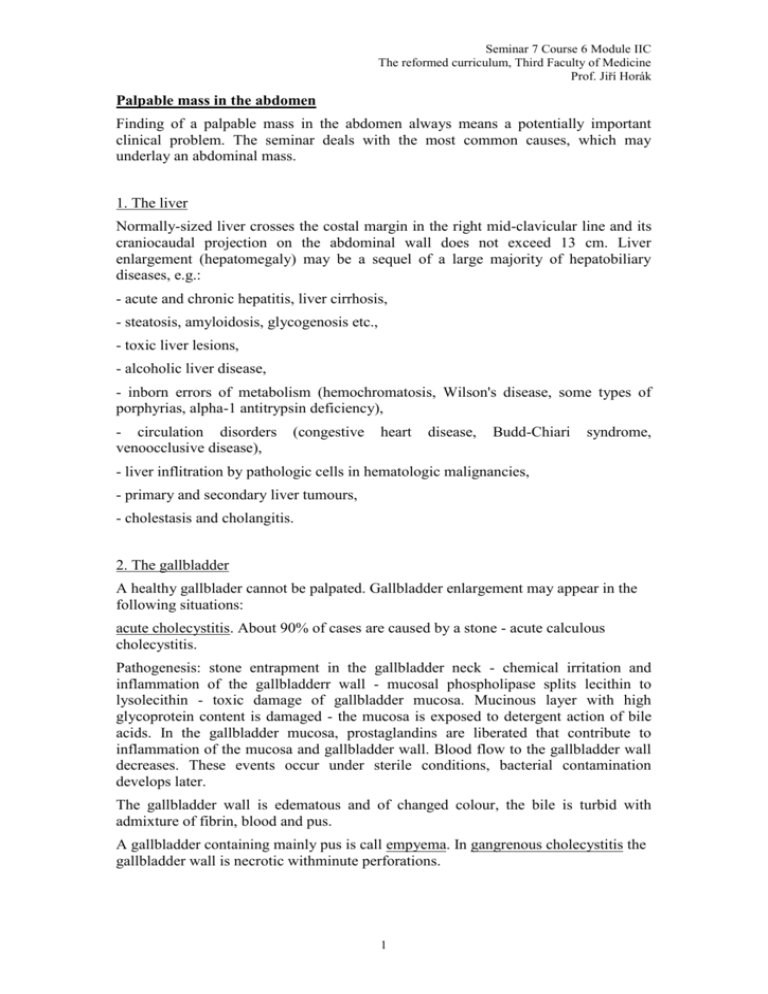
Seminar 7 Course 6 Module IIC The reformed curriculum, Third Faculty of Medicine Prof. Jiří Horák Palpable mass in the abdomen Finding of a palpable mass in the abdomen always means a potentially important clinical problem. The seminar deals with the most common causes, which may underlay an abdominal mass. 1. The liver Normally-sized liver crosses the costal margin in the right mid-clavicular line and its craniocaudal projection on the abdominal wall does not exceed 13 cm. Liver enlargement (hepatomegaly) may be a sequel of a large majority of hepatobiliary diseases, e.g.: - acute and chronic hepatitis, liver cirrhosis, - steatosis, amyloidosis, glycogenosis etc., - toxic liver lesions, - alcoholic liver disease, - inborn errors of metabolism (hemochromatosis, Wilson's disease, some types of porphyrias, alpha-1 antitrypsin deficiency), - circulation disorders venoocclusive disease), (congestive heart disease, Budd-Chiari syndrome, - liver inflitration by pathologic cells in hematologic malignancies, - primary and secondary liver tumours, - cholestasis and cholangitis. 2. The gallbladder A healthy gallblader cannot be palpated. Gallbladder enlargement may appear in the following situations: acute cholecystitis. About 90% of cases are caused by a stone - acute calculous cholecystitis. Pathogenesis: stone entrapment in the gallbladder neck - chemical irritation and inflammation of the gallbladderr wall - mucosal phospholipase splits lecithin to lysolecithin - toxic damage of gallbladder mucosa. Mucinous layer with high glycoprotein content is damaged - the mucosa is exposed to detergent action of bile acids. In the gallbladder mucosa, prostaglandins are liberated that contribute to inflammation of the mucosa and gallbladder wall. Blood flow to the gallbladder wall decreases. These events occur under sterile conditions, bacterial contamination develops later. The gallbladder wall is edematous and of changed colour, the bile is turbid with admixture of fibrin, blood and pus. A gallbladder containing mainly pus is call empyema. In gangrenous cholecystitis the gallbladder wall is necrotic withminute perforations. 1 Seminar 7 Course 6 Module IIC The reformed curriculum, Third Faculty of Medicine Prof. Jiří Horák Acute acalculous cholecystitis It occurs mainly in the following conditions: - severe trauma, - large burns, - conditions after major surgery outside of the hepatobiliary area, - multiple organ failure, - sepsis, - long-term parenteral nutrition, - following the delivery. Less painful forms come about in systemic vasculitis, general atherosclerosis and AIDS. Pathogenesis: the main role plays an ischemic lesion of the gallbladder wall, to which the following factors contribute: - dehydration, - repeated blood transfusions with the subsequent overproduction of bile pigments, - accumulation of viscous bile and mucus resulting in a stone-free cystic duct obstruction, - inflammation and edema of the gallbladder with impaired blood-flow, - bacterial contamination of the bile with lysolecthin production. Clinical presentation of acute acalculous cholecystitis is the same as in calculous cholecystitis but it is frequently masked by the symptoms of the underlying disease. Physical findings: An inflamed gallbladder may be palpable as an ovoid mass, sometimes reaching below the umbilicus, in other patients only the fundus is palpable. In case of pericholecystitis with localized peritonitis a larger inflammatory mass may be palpable. In slight cases the gallbladder cannot be palpated and we find only the Murphy's sign. In chronic cholecystitits, the gallbladder is usually small, retracted and non-palpable. Non-inflammatory gallbladder dilatation It occurs in tumours of the head of the pancreas and distal choledochus (the Courvoisier's sign). The gallbladder is dilated due to the secretory pressure of the bile in biliary obstruction. Palpation is non-tender. Tumours of the gallbladder Gallbladder carcinoma arises usually in chronic cholecystitis and usually is palpable only when it infiltrates the adjacent liver parenchyma. 2 Seminar 7 Course 6 Module IIC The reformed curriculum, Third Faculty of Medicine Prof. Jiří Horák 3. The stomach Under normal circumstances the stomach is not palpable or otherwise amenable to physical examination. A large gastric tumour or a dilated stomach filled with fluid as in gastroparesis, pylorostenosis etc. may be palpable. Rarely, we can palpate a stomach filled with condensed food or hairs (bezoar, trichobezoar). 4. The pancreas Pancreas is located in the retroperitoneum and normally it is not amenable to physical examination. However, it can be palpated under the following circumstances: - pancreatic carcinoma, - pseudocyst of the pancreas, arising as a sequel of an acute pancreatitis, - a genuine pancreatic cyst (rarely). 5. The spleen A normal spleen is not palpable and it weighs about 150 g. If a spleen can be palpated it means that it is enlarged markedly. The main causes of splenomegaly are as follows: - infectious diseases: - bacterial endocarditis and sepsis, - infection mononucleosis, - tuberculosis, - typhus, - brucellosis, - cyomegalovirus infection, - syphilis, - malaria, - histoplasmosis, - toxoplasmosis, - kala-azar, - trypanosomiasis, - schistosomiasis, - leishmaniosis, - echinococcosis, - congestive splenomegaly in portal hypertension, - spleen infiltration by malignant cells: - Hodgkin's disease, - non-Hodgkin lymphomas, 3 Seminar 7 Course 6 Module IIC The reformed curriculum, Third Faculty of Medicine Prof. Jiří Horák - multiple myeloma, - histiocytosis, - myeloproliferative syndromes (chronic myeloid leukemia, polycythemia vera, myeloid metaplasia with myelofibrosis - extramedullar hematopoiesis), - chronic lymphadenosis, - acute leukemia (not always), - autoimmune inflammations: - rheumatoid arthritis, - Felty's syndrome, - systemic lupus erythematodes, - hemolytic anemias: - autoimmune hemolytic anemia, - hereditery spherocytosis, - hemoglobinopathies, - glycogenoses, mucopolysaccharidoses and other thesaurismoses, - amyloidosis, - primary and secondary splenic tumours. In congestive splenomegaly collagen is deposited in the walls of splenic sinusoids, blood flow through the spleen is slowed down and the exposition of blood cells to splenic macrophages increases - hypersplenism (enlarged spleen and loss of blood cells of at least one cell line, which disappears following splenectomy) 6. The kidney A normally-sized and located kidney is not palpable. A kidney may be palpated under the following circumstances: - dystopia of the kidney and a wandering kidney, - renal polycystosis, - hydronephrosis, - tumour of a kidney or an adrenal gland. 7. The intestine The intestine or its contents may be palpable under the following conditions: - condensed stools (scybala), - contracted intestine in the irritable bowel syndrome or in ulcerative colitis (usually the colon descendens and sigma), - Crohn's disease, - inflammatory infiltrate in appendicitis, diverticulitis etc., 4 Seminar 7 Course 6 Module IIC The reformed curriculum, Third Faculty of Medicine Prof. Jiří Horák - contraction of the intestinal loops at the beginning of an obstructive ileus, - large tumours. 8. The urinary bladder - retention of the urine. 9. Female reproductive organs - enlarged uterus (gravidity, myoma, tumours), - extrauterine gravidity. 10. The lymph nodes - inflammatory lymphadenomegaly (esp. in children), - Whipple's disease, - lymphoma, - metastases to the lymph nodes (seminoma etc.) 11. The peritoneum - TBC peritonitis, - tumour infiltration of the omentum 12. Other causes - abscess, - tumours of unknown origin. -------------------------------- 5
